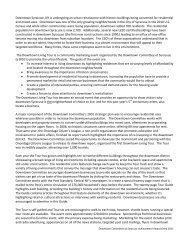The Value of Investing in Canadian Downtowns - International ...
The Value of Investing in Canadian Downtowns - International ...
The Value of Investing in Canadian Downtowns - International ...
You also want an ePaper? Increase the reach of your titles
YUMPU automatically turns print PDFs into web optimized ePapers that Google loves.
Downtown Ottawa<br />
comprises 0.1% <strong>of</strong> the<br />
City <strong>of</strong> Ottawa’s total land<br />
area<br />
VISIONARY<br />
Does the downtown have strong leaders who collaborate to achieve a shared vision?<br />
Downtown Ottawa is envisioned as a beautiful and<br />
<strong>in</strong>spir<strong>in</strong>g focal po<strong>in</strong>t for the city, with a rich local<br />
history that is <strong>in</strong>tegrated with the City's unique role as<br />
Canada's National Capital. <strong>The</strong> City also envisions an<br />
<strong>in</strong>creased residential population that will be<br />
accommodated through urbanization projects.<br />
Vision<br />
<strong>The</strong> current vision for downtown Ottawa is largely<br />
expressed through the downtown Ottawa Urban<br />
Design Strategy 20/20 that dates from 2004. This<br />
study established a broad urban design framework<br />
that aimed to create a lively downtown for residents<br />
and visitors alike. <strong>The</strong> vision for downtown Ottawa<br />
also focuses on the City’s heritage qualities and the<br />
downtown’s role as a national capital.<br />
Ottawa’s vision for a stronger residential population<br />
emerged <strong>in</strong> the 1960s-80s when there was an exodus<br />
<strong>of</strong> residents from the downtown. To respond to this,<br />
the former City <strong>of</strong> Ottawa developed a new Official<br />
Plan <strong>in</strong> the late 1980s that outl<strong>in</strong>ed strong policies to<br />
67<br />
revitalize ‘<strong>The</strong> Central Area.’ While this plan did not<br />
have any highly specialized or advanced policies to<br />
support downtown growth, it did ‘get people excited<br />
about the downtown.’ This was followed by a strategic<br />
decision <strong>in</strong> 1994, when the City placed a moratorium<br />
on development charges <strong>in</strong> Ottawa’s downtown core<br />
under a program known as Re-Do-It (Residential<br />
Downtown Intensification). <strong>The</strong> program was a<br />
success, attract<strong>in</strong>g 1,100 new residents to the<br />
downtown core. 10 However the absence <strong>of</strong><br />
development charges created challenges for the City<br />
to fund upgrades to some <strong>of</strong> its ag<strong>in</strong>g <strong>in</strong>frastructure.<br />
While the City made use <strong>of</strong> Section 37 agreements<br />
under the Ontario Plann<strong>in</strong>g Act (where municipalities<br />
negotiate development density <strong>in</strong> exchange for<br />
facilities and services) it still struggled to cover all<br />
associated costs. Given this challenge and the strong<br />
surge <strong>in</strong> residential development, development<br />
10<br />
<strong>Canadian</strong> Mortgage and Hous<strong>in</strong>g Corporation. (No Date). Adaptive<br />
Reuse: Conversion <strong>of</strong> a commercial build<strong>in</strong>g to condom<strong>in</strong>ium apartments.<br />
Retrieved from:: http://www.cmhcschl.gc.ca/en/<strong>in</strong>pr/bude/himu/<strong>in</strong>bu/upload/<strong>The</strong>-Laura-Secord-Build<strong>in</strong>g.pdf.<br />
Accessed 2012 February 29.
















